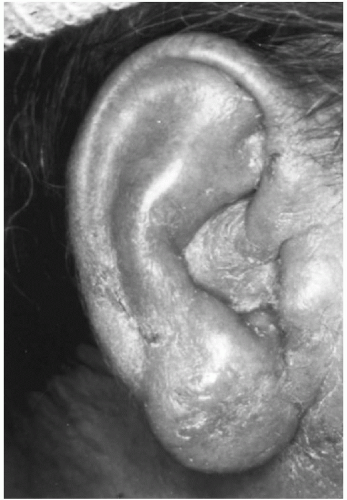Aural pain and pruritus are common symptoms reported either together or separately. Ear itching usually originates in the skin of the external ear, but may arise from middle ear pathology, generalized medical conditions, and self-inflicted trauma secondary to psychiatric illness. Ear pain may be otogenic—that is, derived from the ear—or may be referred from a distant source (
Table 8-1).
In the otologic history, the duration and quality of otalgia or pruritis should be determined, as well as history of hearing loss, tinnitus, vertigo, otorrhea, aural fullness, and previous ear trauma or surgery. Other medical conditions such as psoriasis or psychiatric illnesses that might predispose a patient to itching should be investigated. In the case of suspected referred otalgia, questions regarding oral and dental diseases, head and neck lesions, dysphagia, odynophagia, fevers, and weight loss may be warranted.
Physical examination begins with inspection of the pinna and adjacent areas followed by otoscopic evaluation of the external ear canal and tympanic membrane. Skin changes that produce pruritis should be identified such as scaling, flaking, lichenification, crusting, or cerumen. Pain-producing skin changes such as edema, drainage, foreign bodies, or traumatic changes should be documented. The tympanic membrane and related structures should be closely examined, and pneumatic otoscopy should be performed. A tuning fork exam should also be included. If on exam, no source of otalgia is found, a full head and neck exam should be done to find a source of referred pain. The following disorders (
Table 8-1) should be considered in assessing ear pain.
BACTERIAL OTITIS EXTERNA
Bacterial otitis externa is a frequent cause of itching and otalgia. Disruptions of normal canal skin or the lipid film overlying the canal enable infection of the apopilosebaceous unit (sebaceous and apocrine glands associated with hair follicles responsible for the production of cerumen). The most common pathogens implicated are Pseudomonas aeruginosa, Staphyloccus aureus, proteus, and Streptococcal organisms. Warm, humid weather and swimming often predisposes the ear to this condition. At early stages the patient has a sense of mild itching and congestion of the ear. Proliferation of bacteria in locally macerated skin leads to an itch-scratch cycle that perpetuates further infection. The patient then reports otalgia, pruritis, otorrhea, and possibly diminished hearing if the edema and debris sufficiently occlude the canal. On exam, the auricle may be tender to palpation. The external auditory canal is edematous, mildly erythematous, and foul smelling; whitish to greenish exudate is present. The tympanic membrane may be obscured when the edema and exudate are severe.
Successful treatment depends on careful and complete removal of all debris, because the debris obstructs the apocrine and sebaceous glands occupied by the infection. Although mild infections respond to cleaning and acidification of the ear canal with dilute acetic acid solutions, most infections require topical antibiotic drops. Commonly used drops include a combination of topical antibiotics with or without steroids. Ophthalmic preparations have also been used successfully to manage ear disease, although the U.S. Food and Drug Administration has not approved these agents for use in the ear (
Table 8-2). When severe canal edema prevents drops from entering the ear, a ½-inch or ¼-inch (1.3 or 0.6 cm) gauze wick or sponge wick can be inserted in the ear canal from 6 hours to 3 days to facilitate adequate entry of drops. When the wick is removed, the canal edema should be sufficiently reduced to allow the drops to enter the ear canal. Oral antibiotics should be used when accompanying cellulitis is present (
Fig. 8-1). If the patient does not respond and eczematoid changes develop in the ear canal and adjacent skin, allergy to neomycin or another ingredient of the drops should be suspected.
In the treatment of patients with recurrent otitis externa, prevention is instrumental. The patient should be cautioned to avoid further trauma to the ear and specifically to avoid heat,
humidity, and insertion of foreign materials into the ear canal. Custom-fitted ear molds are available for swimmers. The use of an acidifying drop after swimming is helpful.



 Get Clinical Tree app for offline access
Get Clinical Tree app for offline access
